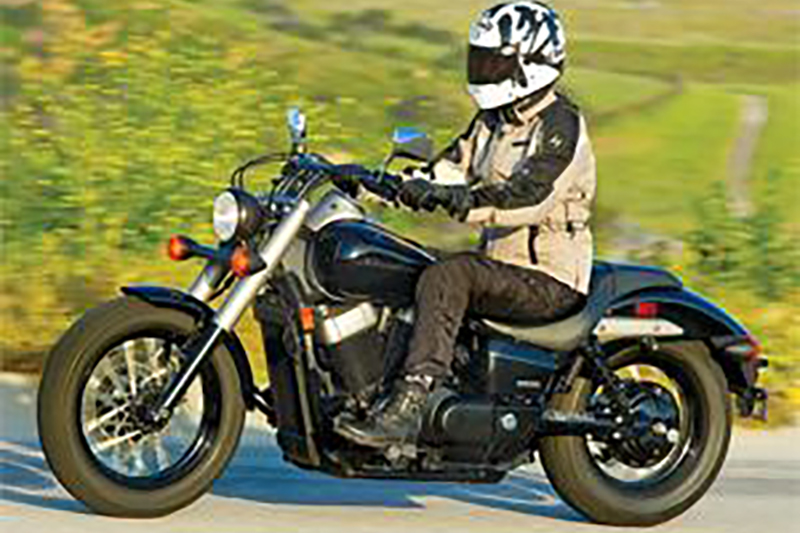2010 Honda Shadow Phantom 750

Road Test Review
Dramatist Seán O’Casey said, “All the world’s a stage and most of us are desperately unrehearsed.” This profound insight applies to me more often than I care to admit, and I sometimes wonder if people such as the Honda engineers who came up with the thriving Shadow line can relate. The first Shadow model appeared on-stage in 1983 and here the company is, 27 years later, still expanding the line because it’s so popular. For 2010, the new Honda Shadow Phantom 750 takes a bow.
It’s not exactly all new, as the liquid-cooled, 52-degree, 745cc, SOHC, three-valve-per-cylinder V-twin is the same engine that’s been residing in Honda’s middle-child line for many years. The Phantom is one of four 750cc Shadows in the 2010 lineup, which also includes the new RS and successful Spirit and Aero models. The Phantom looks more like its Spirit sibling with its bobtail fender, but if you compare specs it has more in common with the retro-looking Aero. The big change is that the Phantom is the first fuel-injected 745cc V-twin engine in the Shadow family. It gets its juice from Honda’s PGM-FI with a 34mm throttle body and an automatic enrichment circuit. With this more efficient addition comes about the same output (38 horsepower and 43 lb-ft of torque at the rear wheel) and slightly more (.2 gallons) fuel capacity. And a lighter wallet, as at $7,999, the Phantom costs $1,000 more than either the Spirit or the Aero.
Forward-mounted pegs and a handlebar that places your arms in a relaxed position allow you to either sit upright or ride along in a typical cruiser slouch. The adequately padded seat is lower than low at 25.7 inches (same as Honda’s Spirit and even lower than the Aero), and will especially appeal to short-inseamed riders. With my 35-inch inseam it’s a long way down to the seat, and I’d like a little more legroom, but once I’m riding along this compact cruiser doesn’t seem so compact anymore.
The Phantom’s seat dips down so you’re sitting in it, rather than on it, and the lip that bumps up to the passenger portion of the seat provides some lower back support for the rider. For an unfaired motorcycle, windblast to the rider is minimal. The only issue I had was one morning when gusty winds were coming from every which way and pushed my helmet into my face. I really would have liked a windscreen in front of me that day. One is available from Honda for $259.95, along with many other factory accessories.
On the highway, the suspension is better controlled than expected from the black dual shocks with just 3.5 inches of travel. The engine is smooth at all legal speeds and cruising along at a leisurely pace on a back road or at 65-70 mph on the highway is where bike and rider are happiest. Shifting through the five-speed tranny and finding neutral is done without difficulty. Adding to the uncomplicated handling of the Phantom are low-effort controls and an easy-to-modulate clutch with a wide friction zone that’s good for newbie riders. The drum rear brake could use more bite, however, in concert with the front single disc with twin-piston caliper, the combination stops the 544-pound machine quickly.
As expected, there’s not much cornering clearance with about 8 1/2 inches between the Phantom’s pegs and the pavement when the bike is upright. If clearance weren’t an issue, this bike could be ridden quickly through the twisties as it’s stable and stays on track very well. There’s good, usable power in the lower rev range, the suspension is not easily upset when you change direction quickly and the Dunlop D404 tires stick fast to the pavement. Basically, I feel very secure getting the Phantom leaned over in a series of corners. Everything on this bike is so well orchestrated that I can cruise along contentedly for many miles. I remember one evening in particular when it was just me and the Phantom in the canyons, with the sound of the bike echoing off the hillsides and me singing “The Music of the Night” from The Phantom of the Opera inside my helmet.
While the turn-signal indicator and low-fuel light are within your normal field of vision, you have to look down to see the other gauges if you wear a full-face helmet, including the tank-mounted speedometer and the neutral light. Funny, sometimes for a split second I mistake the green turn-signal indicator for the neutral light because of its location TDC on the triple clamp…in my mind that’s where a neutral light should be. The rectangular mirrors are steady and provide a good rear view.
As it’s competitively priced, the Phantom seems aimed squarely at other blacked-out bikes like the Harley-Davidson Sportster Iron 883. If Honda’s intention was to target short-inseamed riders who want to look strapping on an easy-handling, comfortable cruiser and aren’t in a hurry, the company nailed it. Add to that great fuel mileage (our test bike had a high of 57.4 mpg), appealing styling and manageable, usable power, and the company has a hit. Ah ha, Phantom, seems you do “All I Ask of You.” We give it a standing ovation.
